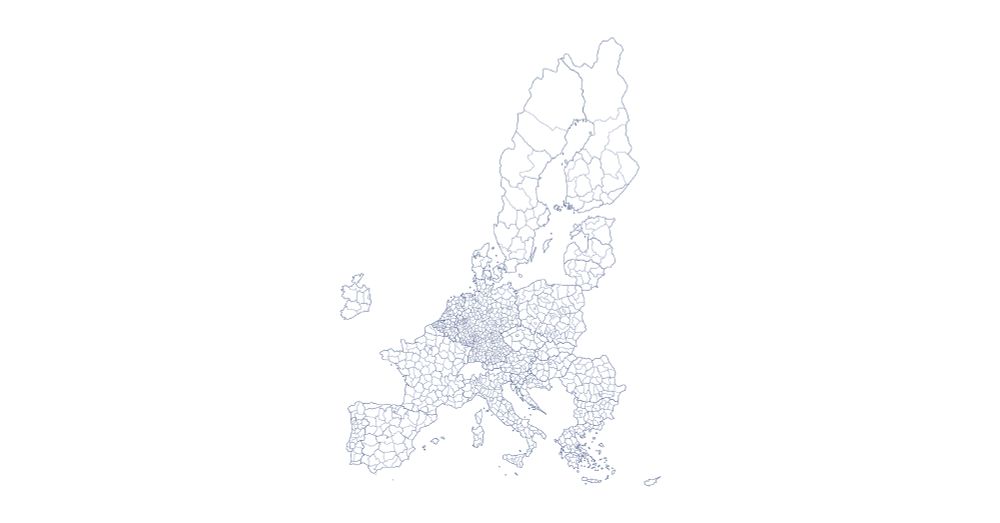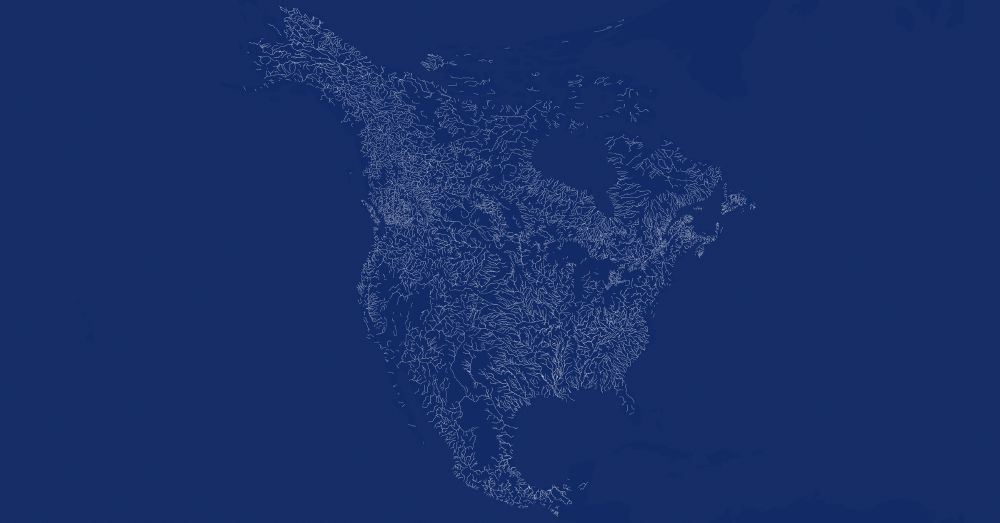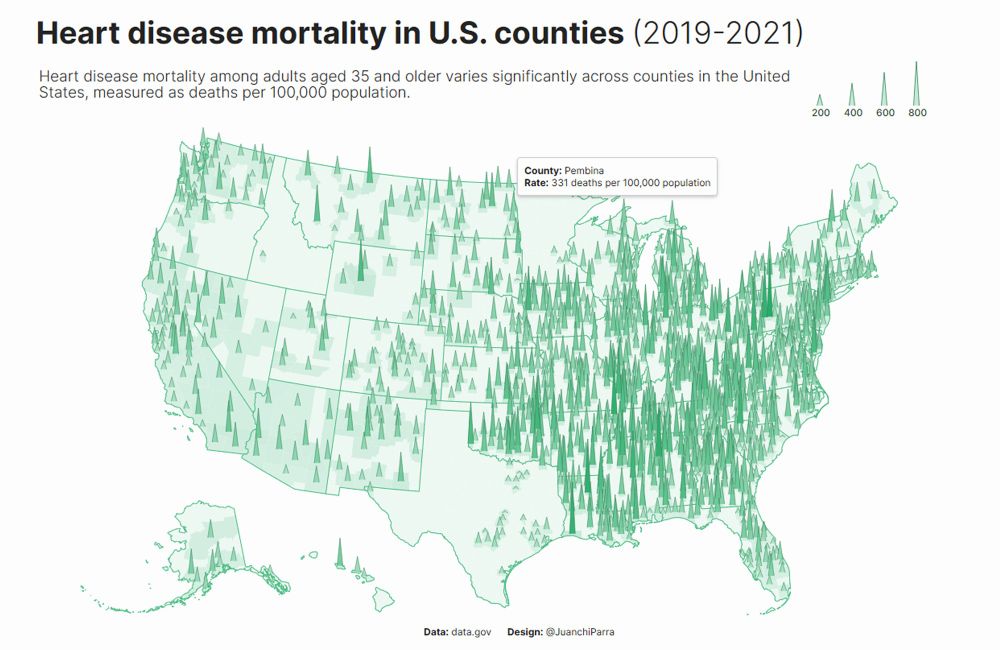For today's challenge, I created a map of the highest peaks in Parque Nacional Sierra Nevada in Mérida, Venezuela.
Tools: QGIS and Figma

For today's challenge, I created a map of the highest peaks in Parque Nacional Sierra Nevada in Mérida, Venezuela.
Tools: QGIS and Figma
For today's challenge, I used personal data from the routes I run and the cats I greet.
Tools: QGIS + Figma

For today's challenge, I used personal data from the routes I run and the cats I greet.
Tools: QGIS + Figma
For today's challenge, I created a representation of the Mississippi River in the United States using its digital elevation model and light detection and ranging.
Tools: QGIS

For today's challenge, I created a representation of the Mississippi River in the United States using its digital elevation model and light detection and ranging.
Tools: QGIS
For today's challenge, I chose to use the “d3.geoAiry” projection for the first time, along with world population data by country.
Tools: D3
For today's challenge, I chose to use the “d3.geoAiry” projection for the first time, along with world population data by country.
Tools: D3
For today's challenge, I created a representation of our solar system (somewhat inaccurate).
Tools: D3

For today's challenge, I created a representation of our solar system (somewhat inaccurate).
Tools: D3
For today's challenge, I decided to recreate the map from two days ago that shows active fires in Brazil. This time, I made it a hexbin map using R and ggplot2.

For today's challenge, I decided to recreate the map from two days ago that shows active fires in Brazil. This time, I made it a hexbin map using R and ggplot2.
For this challenge, I decided to create a grid map displaying the population of the United States by state.
Tools: D3

For this challenge, I decided to create a grid map displaying the population of the United States by state.
Tools: D3
For today's challenge, I used data from NASA satellites showing active fires and thermal anomalies in Brazil over the past seven days.
Tools: D3

For today's challenge, I used data from NASA satellites showing active fires and thermal anomalies in Brazil over the past seven days.
Tools: D3
For today's challenge, I visualized the roads of Barcelona, Spain.
Tools: QGIS

For today's challenge, I visualized the roads of Barcelona, Spain.
Tools: QGIS
For today's challenge, I created a polygon representation of the city of Mérida, Venezuela, including the surrounding mountains.
This is one of the first effects I learned to implement in QGIS, and it took me about 5:42 minutes to complete.
Tools: QGIS

For today's challenge, I created a polygon representation of the city of Mérida, Venezuela, including the surrounding mountains.
This is one of the first effects I learned to implement in QGIS, and it took me about 5:42 minutes to complete.
Tools: QGIS
For today's challenge, I imagined what some countries might look like in 2125
Can't you see anything beyond the sea? This scenario could become a reality for some low-lying countries as climate change poses a significant threat to their existence
Tools: Figma




For today's challenge, I imagined what some countries might look like in 2125
Can't you see anything beyond the sea? This scenario could become a reality for some low-lying countries as climate change poses a significant threat to their existence
Tools: Figma
For today's challenge, I visualized the main streets of Caracas.
Tools: QGIS + Figma

For today's challenge, I visualized the main streets of Caracas.
Tools: QGIS + Figma



For today's challenge, I have mapped the most frequent weekly flight routes from Argentina, Chile, Colombia, and Panama.
Tools: D3 and Svelte
For today's challenge, I have mapped the most frequent weekly flight routes from Argentina, Chile, Colombia, and Panama.
Tools: D3 and Svelte

For today's challenge, I decided to create a map showing the population density of municipalities in Spain.
I was surprised to learn that there are two municipalities with only three inhabitants.
Tools: QGIS and Figma

For today's challenge, I decided to create a map showing the population density of municipalities in Spain.
I was surprised to learn that there are two municipalities with only three inhabitants.
Tools: QGIS and Figma
To complete this week, I visualized the proximity of healthcare services in Italy by analyzing road travel times.
Tools: QGIS and Figma

To complete this week, I visualized the proximity of healthcare services in Italy by analyzing road travel times.
Tools: QGIS and Figma
For today's challenge, I created a population density map of Chile.
I'm excited to continue improving my skills with QGIS.
Tools: QGIS and Aerialod




For today's challenge, I created a population density map of Chile.
I'm excited to continue improving my skills with QGIS.
Tools: QGIS and Aerialod


For today's challenge, I transformed a 1963 map from Venezuela's former Ministry of Public Works by incorporating the corresponding elevation and terrain data.
Tools: QGIS and Blender



For today's challenge, I transformed a 1963 map from Venezuela's former Ministry of Public Works by incorporating the corresponding elevation and terrain data.
Tools: QGIS and Blender
For today's challenge, I analyzed data from my running activities (14 months)
• Activities: 168
• Total hours: 196,9
• Total distance: 1.717,27 kilometers
• Average per day: 10,47 kilometers
Tools: Strava, Svelte and MapLibre GL JS + CARTO



For today's challenge, I analyzed data from my running activities (14 months)
• Activities: 168
• Total hours: 196,9
• Total distance: 1.717,27 kilometers
• Average per day: 10,47 kilometers
Tools: Strava, Svelte and MapLibre GL JS + CARTO
For this challenge, I chose to illustrate the borders of the countries in the European Union.
Tools: D3


For this challenge, I chose to illustrate the borders of the countries in the European Union.
Tools: D3
For the second challenge, I mapped the rivers and waterways in North America.
Tools: QGIS and D3

For the second challenge, I mapped the rivers and waterways in North America.
Tools: QGIS and D3
For the first challenge, I represented the geographical distribution of over 15,000 Starbucks locations in the United States.
Tools: D3

For the first challenge, I represented the geographical distribution of over 15,000 Starbucks locations in the United States.
Tools: D3
For this last challenge, I moved away from the main idea and the prompt, but I liked the result. Very happy to have done all the challenges.
For those who want to see the source code: github.com/juanchiparra...

For this last challenge, I moved away from the main idea and the prompt, but I liked the result. Very happy to have done all the challenges.
For those who want to see the source code: github.com/juanchiparra...

